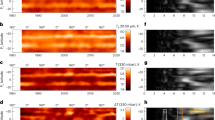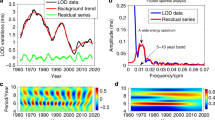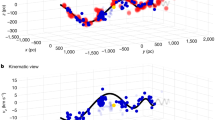Abstract
The internal rotation rates of the giant planets can be estimated by cloud motions, but such an approach is not very precise because absolute wind speeds are not known a priori and depend on latitude1: periodicities in the radio emissions, thought to be tied to the internal planetary magnetic field, are used instead2,3,4,5. Saturn, despite an apparently axisymmetric magnetic field6, emits kilometre-wavelength (radio) photons from auroral sources. This emission is modulated at a period initially identified as 10 h 39 min 24 ± 7 s, and this has been adopted as Saturn’s rotation period3. Subsequent observations7,8, however, revealed that this period varies by ±6 min on a timescale of several months to years. Here we report that the kilometric radiation period varies systematically by ±1% with a characteristic timescale of 20–30 days. Here we show that these fluctuations are correlated with solar wind speed at Saturn, meaning that Saturn’s radio clock is controlled, at least in part, by conditions external to the planet’s magnetosphere. No correlation is found with the solar wind density, dynamic pressure or magnetic field; the solar wind speed therefore has a special function. We also show that the long-term fluctuations are simply an average of the short-term ones, and therefore the long-term variations are probably also driven by changes in the solar wind.
This is a preview of subscription content, access via your institution
Access options
Subscribe to this journal
Receive 51 print issues and online access
$199.00 per year
only $3.90 per issue
Buy this article
- Purchase on Springer Link
- Instant access to full article PDF
Prices may be subject to local taxes which are calculated during checkout



Similar content being viewed by others
References
Sanchez-Lavega, A. How long is the day on Saturn? Science 307, 1223–1224 (2005)
Higgins, C. A., Carr, T. D., Reyes, F., Greenman, W. B. & Lebo, G. R. A redefinition of Jupiter’s rotation period. J. Geophys. Res. 102, 22033–22041 (1997)
Desch, M. D. & Kaiser, M. L. Voyager measurement of the rotation period of Saturn’s magnetic field. Geophys. Res. Lett. 8, 253–256 (1981)
Desch, M. D., Connerney, J. E. P. & Kaiser, M. L. The rotation period of Uranus. Nature 322, 42–43 (1986)
Lecacheux, A., Zarka, P., Desch, M. D. & Evans, D. R. The sidereal rotation period of Neptune. Geophys. Res. Lett. 20, 2711–2714 (1993)
Connerney, J. E. P., Ness, N. F. & Acuña, M. H. Zonal harmonic model of Saturn’s magnetic field from Voyager 1 and 2 observations. Nature 298, 44–46 (1982)
Galopeau, P. H. M. & Lecacheux, A. Variations in Saturn’s radio rotation period measured at kilometer wavelengths. J. Geophys. Res. 105, 13089–13101 (2000)
Gurnett, D. A. et al. Radio and plasma wave observations at Saturn from Cassini’s approach and first orbit. Science 307, 1255–1259 (2005)
Zarka, P. Auroral radio emissions at the outer planets: Observations and theories. J. Geophys. Res. 103, 20159–20194 (1998)
Zarka, P. in Planetary Radio Emissions II (eds Rucker, H. O., Bauer, S. J. & Pedersen, B. M.) 327–342 (Austrian Acad. Sci. Press, Vienna, 1988)
Ness, N. F. in Planetary Radio Emissions II (eds Rucker, H. O., Bauer, S. J. & Pedersen, B. M.) 3–13 (Austrian Acad. Sci. Press, Vienna, 1988)
Warwick, J. W. et al. Planetary radio astronomy observations from Voyager 1 near Saturn. Science 212, 239–243 (1981)
Galopeau, P. H. M., Zarka, P. & Le Quéau, D. Source location of Saturn’s kilometric radiation: The Kelvin–Helmholtz instability hypothesis. J. Geophys. Res. 100, 26397–26410 (1995)
Galopeau, P., Ortega-Molina, A. & Zarka, P. Evidence of Saturn’s magnetic field anomaly from SKR high-frequency limit. J. Geophys. Res. 96, 14129–14140 (1991)
Connerney, J. E. P. & Desch, M. D. Comment on: ‘Evidence of Saturn’s magnetic field anomaly from SKR high-frequency limit’ by Galopeau et al . J. Geophys. Res. 97, 8713–8717 (1992)
Galopeau, P. & Zarka, P. Reply to the Comment on: ‘Evidence of Saturn’s magnetic field anomaly from SKR high-frequency limit’ by Connerney & Desch. J. Geophys. Res. 97, 12291–12297 (1992)
Kurth, W. S., Lecacheux, A., Averkamp, T. F., Groene, J. B. & Gurnett, D. A. A Saturnian longitude system based on a variable kilometric radiation period. Geophys. Res. Lett. 34 L02201 doi: 10.1029/2006GL028336 (2007)
Cecconi, B. & Zarka, P. Model of a variable radio period for Saturn. J. Geophys. Res. 110 A12203 doi: 10.1029/2005JA011085 (2005)
Gurnett, D. A. et al. The variable rotation period of the inner region of Saturn’s plasma disk. Science 316, 442–445 (2007); published online 22 March 2007
Desch, M. D. Evidence for solar wind control of Saturn radio emission. J. Geophys. Res. 87, 4549–4554 (1982)
Desch, M. D. & Rucker, H. O. The relationship between Saturn kilometric radiation and the solar wind. J. Geophys. Res. 88, 8999–9006 (1983)
Bevington, P. R. & Robinson, D. K. Data Reduction and Error Analysis for the Physical Sciences 2nd edn 198–200 (McGraw-Hill, New York, 1992)
Tao, C., Kataoka, R., Fukunishi, H., Takahashi, Y. & Yokoyama, T. Magnetic field variations in the Jovian magnetotail induced by solar wind dynamic pressure enhancements. J. Geophys. Res. 110 A11208 doi: 10.1029/2004JA010959 (2005)
Prangé, R. et al. An interplanetary shock traced by planetary auroral storms from the Sun to Saturn. Nature 432, 78–81 (2004)
Hanlon, P. G. et al. On the evolution of the solar wind between 1 and 5 AU at the time of the Cassini Jupiter flyby: Multispacecraft observations of interplanetary coronal mass ejections including the formation of a merged interaction region. J. Geophys. Res. 109 A09S03 doi: 10.1029/2003JA010112 (2004)
Espinosa, S. E., Southwood, D. J. & Dougherty, M. K. How can Saturn impose its rotation period in a noncorotating magnetosphere? J. Geophys. Res. A. 108 1086 doi: 10.1029/2001JA005084 (2003)
Cowley, S. W. H. et al. Cassini observations of planetary-period magnetic field oscillations in Saturn’s magnetosphere: Doppler shifts and phase motion. Geophys. Res. Lett. 33, L07104 10.1029/2005GL025522. (2006)
Southwood, D. J., Dougherty, M. K. & Kivelson, M. G. Time variability in Saturn’s magnetic rotation. Presented at American Geophysical Union Fall Meeting 2006. abstract P52A-08 (2006)
Clarke, K. E. et al. Cassini observations of planetary-period oscillations of Saturn’s magnetopause. Geophys. Res. Lett. 33 L23104 doi: 10.1029/2006GL027821 (2006)
Cecconi, B., Zarka, P. & Kurth, W. S. in Planetary Radio Emissions VI (eds Rucker, H. O., Kurth, W. S. & Mann, G.) 37–49 (Austrian Acad. Sci. Press, Vienna, 2006)
Acknowledgements
We thank D. Southwood for a seminar at Meudon Observatory; F. Mottez, S. Hess and J.-M. Griessmeier for early inputs; B. Kurth for comments on the manuscript; D. Pelat for advice on the statistical analysis; Cassini Radio and Plasma Wave Science (RPWS) engineers at the University of Iowa and the Laboratoire d’Études Spatiales et d’Instrumentation en Astrophysique for support on instrumental questions and ephemeris; and N. Letourneur for processing RPWS data. The French co-authors acknowledge support from the Centre National d’Études Spatiales.
Author Contributions P.Z., L.L., B.C. and R.P. contributed equally to this work. H.O.R. contributed to the projection of solar wind data. P.Z. wrote the paper. All authors discussed the results and commented on the manuscript.
Author information
Authors and Affiliations
Corresponding author
Ethics declarations
Competing interests
The authors declare no competing financial interests.
Supplementary information
Supplementary Figures
The file contains Supplementary Figures S1-S3 with Legends. (PDF 1103 kb)
Rights and permissions
About this article
Cite this article
Zarka, P., Lamy, L., Cecconi, B. et al. Modulation of Saturn’s radio clock by solar wind speed. Nature 450, 265–267 (2007). https://doi.org/10.1038/nature06237
Received:
Accepted:
Issue Date:
DOI: https://doi.org/10.1038/nature06237
This article is cited by
-
Auroral Processes at the Giant Planets: Energy Deposition, Emission Mechanisms, Morphology and Spectra
Space Science Reviews (2015)
-
Large-Scale Structure and Dynamics of the Magnetotails of Mercury, Earth, Jupiter and Saturn
Space Science Reviews (2014)
-
Farside explorer: unique science from a mission to the farside of the moon
Experimental Astronomy (2012)
-
Mapping Magnetospheric Equatorial Regions at Saturn from Cassini Prime Mission Observations
Space Science Reviews (2011)
Comments
By submitting a comment you agree to abide by our Terms and Community Guidelines. If you find something abusive or that does not comply with our terms or guidelines please flag it as inappropriate.



